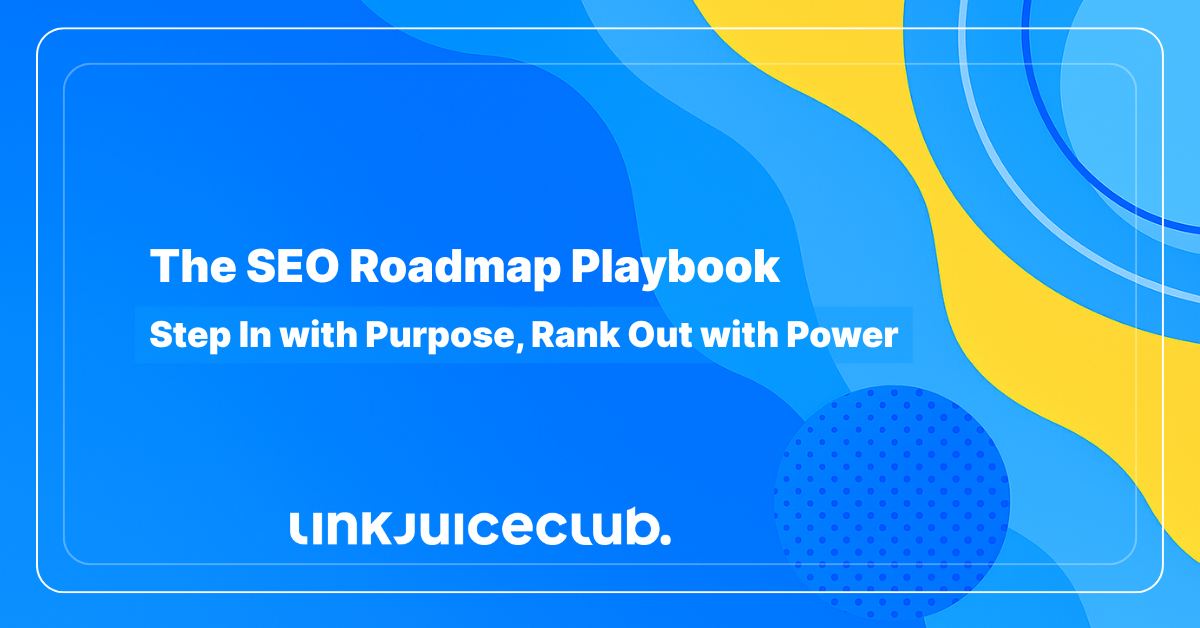
The SEO Roadmap Playbook: Step In with Purpose, Rank Out with Power
Every winning strategy starts with an SEO roadmap — and in SEO, that map isn’t optional. It’s the roadmap that separates those who scale with precision from those who just scatter keywords and hope for the best.
As the calendar flips to a fresh year (or even a new quarter), now’s the perfect time to either fine-tune your SEO game plan or build one from scratch. Because let’s face it — without direction, even the best content falls flat.
🔍 Still running on “let’s just publish and pray”? That’s old-school.
🎯 A proper SEO roadmap gives you clarity, focus, and measurable goals — not just guesses.
Here’s what’s coming your way:
- A step-by-step breakdown of what an SEO roadmap actually looks like
- Key components you can’t afford to skip
- Scalable tactics that bring ROI — not just rankings
- Real-world tips for turning strategy into momentum
Whether you’re revamping your existing framework or building your first from the ground up, this playbook is built to move you forward — with purpose, not panic.
Let’s chart a course that doesn’t just chase trends… but builds rankings that stick.

First, Let’s Set the Map: What Is an SEO Roadmap, Really?
Think of your SEO roadmap as your digital GPS — guiding every crawlable path, from the backroads of broken links to the fast lanes of high-converting content. It’s not just a to-do list — it’s your strategic compass, pointing toward visibility, authority, and ROI.
At its core, an SEO roadmap is:
- 🧭 A time-bound blueprint detailing what you’ll optimize, why it matters, and when to move.
- 🔍 A breakdown of critical layers: keyword targeting, content planning, on-site optimization, and technical fixes.
- 🛠️ A system for aligning day-to-day execution with long-term business growth.
Instead of wandering in the SERPs wilderness, you’ll move with intention:
- Identify how your audience discovers solutions like yours.
- Create content that mirrors their intent, answers their questions, and earns their trust.
- Tune your technical SEO engine so Google’s crawlers never hit a speed bump.
📌 Pro Insight: A roadmap isn’t just about ranking higher — it’s about prioritizing the right battles based on what moves the needle for your brand.
By connecting your SEO roadmap to broader business objectives (think: revenue goals, product launches, or user acquisition), you:
- 💡 Focus only on actions that serve measurable results
- ⏱️ Allocate resources efficiently — no more wasted hours chasing vanity metrics
- 📊 Build a repeatable system for optimization and iteration
This isn’t guesswork. It’s SEO with a pulse, a plan, and a purpose.
Why Bother with an SEO Roadmap? Because Shooting Blind is Expensive.
You could dive into SEO like a kid into a pool — headfirst, no floaties, no clue where the bottom is. But if you want real, compounding gains, you need more than effort — you need direction.
An SEO roadmap gives you that clarity. It separates the needle-movers from the time-wasters and keeps your execution synced with real business goals.
Here’s what you get when you lead with a roadmap, not just hustle:
- 📌 Prioritization with Purpose
You’ll stop reacting and start targeting. Every task is ranked by impact, not guesswork. - 🎯 Alignment with Business Goals
Whether it’s sales, signups, or visibility — your SEO strategy backs up your KPIs with action. - 💸 Smarter Resource Allocation
Time and budget go where they matter most — high-impact fixes, content with legs, and scalable wins. - 🚀 Visibility with Velocity
Organic traffic climbs steadily when you’re targeting the right people with the right content at the right time. - 🧠 Brand Recognition, Not Just Rankings
The more often you show up with value, the faster your brand becomes a trusted voice in your niche. - ⚡ Agility in a Shifting Search Landscape
When trends shift or algorithms evolve, you pivot fast — because you’re not playing catch-up, you’re playing chess.
Having a roadmap doesn’t mean locking yourself into a rigid plan. It means making smarter, faster decisions that keep you ahead of your less-prepared competitors — the ones still treating SEO like it’s 2013.
Laying the Groundwork: What It Takes to Start Your SEO Roadmap Right
Every high-ranking website began with a plan. Before the traffic, before the leads, before the conversions — there was a roadmap. Your SEO roadmap is the architect’s sketch before the construction begins. You don’t just pour concrete and hope it works — you plan every beam, bolt, and brick.
And here’s the real secret: the planning phase is where the winners get ahead.
Get Clear on the Mission
Start by identifying what success looks like. Are you trying to grow brand visibility, dominate local search, launch a new product line, or simply outrank your competitors? Define your outcome, then reverse-engineer the path to get there.
- Want more leads? Focus on conversion-driven content and high-intent keywords.
- Chasing visibility? Get your technical SEO airtight and chase featured snippets.
- Building authority? Go long on topical depth, E-E-A-T, and linkable assets.
📌 Clarity at this stage isn’t optional — it’s fuel for the rest of your roadmap.
Conduct a Sitewide SEO Audit
Before you set the GPS, you need to know where you are. That’s where your audit comes in — think of it as a comprehensive diagnosis of your SEO health.
📚 1. Content Audit
Your content is the gateway. But if it’s outdated, off-topic, or duplicated, it becomes a dead end.
- Evaluate your existing content — what ranks, what converts, what doesn’t.
- Identify gaps: What are competitors ranking for that you’re not covering?
- Use tools like Ahrefs, Semrush, or Google Search Console to get granular insight.
- Don’t just audit — assign outcomes: update, merge, delete, or expand.
💬 Insight: “Good enough” content isn’t good enough anymore. Every page should earn its spot.
⚙️ 2. Technical SEO Audit
Technical debt builds silently — and it kills performance. You need a clean, crawlable, fast-loading site or Google simply won’t care.
- Use Screaming Frog or Sitebulb to crawl your entire site.
- Look for: crawl errors, redirect chains, broken links, sitemap issues.
- Benchmark Core Web Vitals and mobile responsiveness.
- Prioritize issues based on how much they impact performance.
🛠 Pro move: Fix your foundation before scaling. It pays dividends.
🧭 3. User Experience Check
UX and SEO are joined at the hip. If users bounce or get lost, your rankings will follow suit.
- Is your navigation intuitive?
- Are CTAs visible and compelling?
- Where are users dropping off?
Use Google Analytics, Hotjar, or Clarity to uncover friction points. Turn findings into tasks — if UX is suffering, your roadmap isn’t complete.
🔗 4. Backlink Profile Review
Links still matter — not all of them, but the right ones. A review of your backlink profile helps you understand where you stand in the authority game.
- Use tools like Majestic, Ahrefs, or Moz Link Explorer.
- Identify toxic links, lost links, and missed opportunities.
- Build a list of strategic link acquisition targets based on relevance and trustworthiness.
🚫 Reminder: Don’t obsess over disavows unless you’ve been penalized. Focus on earning better links.
From Insight to Action: How to Build and Scale Your SEO Roadmap
Once your groundwork is done, the SEO roadmap shifts from ideas to execution — and this is where the real movement happens. Now, you’re not just diagnosing — you’re directing the strategy.
Define Your SMART SEO Goals
You need goals that drive performance — not wishlists. Enter the SMART framework: Specific, Measurable, Achievable, Relevant, and Time-bound.
- Specific: “Increase organic leads from product pages by 15%”
- Measurable: “Rank in top 3 for 10 commercial-intent keywords by Q2”
- Achievable: “Publish two high-authority guest posts monthly”
- Relevant: “Aligns with our Q1 initiative to grow B2B signups”
- Time-bound: “Audit and fix all 404 errors by end of month”
Don’t just jot these down in Notion. Tie them directly to the roadmap, assign owners, and link them to KPIs.
Align with Core Business Objectives
Your SEO roadmap isn’t a side quest — it’s part of the main mission. So it must sync with revenue targets, marketing goals, and product rollouts.
- If your business wants market share in a specific region → double down on local SEO.
- Launching a new service? → Focus on topical authority and intent-aligned content.
- Need brand reach? → Go heavy on long-tail keywords, digital PR, and zero-click content.
💡 Pro Tip: Pull in input from sales, marketing, and product — they’ll tell you exactly what matters most right now.
Estimate Resources, Time, and Bandwidth
Don’t plan a skyscraper with a backyard budget. Be realistic about your available talent, tools, and timeline.
- Evaluate internal skills: Who can own what? Where are the gaps?
- Decide on tools: Ahrefs, Surfer, Clearscope, Screaming Frog — what’s essential?
- Budget for support: freelancers, developers, agencies, or consultants if needed.
Set deadlines that reflect real-world conditions — not ideal ones.
Prioritize Like a Pro
You can’t fix everything at once. That’s why you need to stack-rank your tasks.
Here’s a simplified prioritization formula:
- Quick Wins: Easy, fast, high impact (e.g. update title tags, fix broken links)
- Strategic Builders: Harder, but compound over time (e.g. content hubs, backlink campaigns)
- Structural Fixes: Foundation work (e.g. Core Web Vitals, site architecture)
Make sure each initiative has:
- A clear owner
- A deadline
- A metric that tracks its success
Plan to Review and Adjust
Your roadmap is a living thing. It needs maintenance, iteration, and a willingness to adapt.
- Schedule quarterly deep audits and monthly reviews
- Analyze traffic, rankings, crawl data, and conversions
- Meet with internal stakeholders to reassess goals and priorities
- Refine strategies and timelines based on results
🧠 Don’t just chase progress — understand it. Why did X work and Y flop? What patterns are emerging?
The Bottom Line: Why Your SEO Roadmap Is the Strategy Behind the Surge
SEO isn’t magic — it’s a method. And your roadmap is the difference between spinning wheels and building real, lasting momentum in organic search.
When you treat your SEO roadmap like a living, evolving strategy — not a static checklist — you start making smarter moves, faster decisions, and scalable progress.
Here’s the big-picture recap to keep in your pocket:
- ✅ Start with clarity: Know your business goals and define SMART SEO objectives that actually align with them.
- 🔍 Audit before action: Let data guide your steps — from content gaps to technical bugs, you can’t fix what you don’t know exists.
- 🛠 Build with purpose: Use your roadmap to prioritize high-impact, measurable tasks. Think strategy first, tactics second.
- 💬 Collaborate across teams: SEO doesn’t live in a silo. Sync your efforts with marketing, product, dev, and sales.
- 🔁 Review, refine, repeat: A good SEO roadmap adjusts to the terrain. Track performance, test what works, and evolve constantly.
💥 Final Thought: Anyone can chase rankings. But with a strong SEO roadmap, you’re building a system — one that compounds over time, withstands algorithm updates, and aligns directly with your growth goals.
So don’t wing it. Map it, track it, and own the results.





